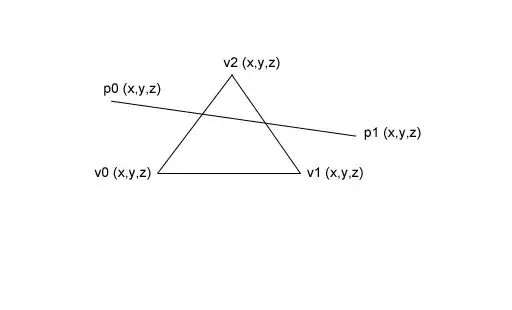The triangle $\Delta(v_0,v_1,v_2)$ defines a plane $\Pi$. If the line $\ell$ is not parallel to $\Pi$ it will intersect the plane in exactly one point $p$. Then we can apply three determinants $det(p,v_0,v_1)$, $det(p,v_1,v_2)$, and $det(p,v_2,v_0)$ determine the orientation (sign) and know if $p$ lies inside of $\Delta$, if so then $\ell$ intersects $\Delta$.
To calculate $p$ we can use the parametric form (Wikipedia):
$\Pi$: $v_0 + (v_1 - v_0)u + (v_2-v_0)w$
Assuming $\ell$ is defined by two points $p_0$ and $p_1$. Then we can write the point of intersection as:
$p_0 + (p_1-p_0)t = v_0 + (v_1 - v_0)u + (v_2-v_0)w$
$\Leftrightarrow p_0 - v_0 = (p_0 - p_1)t + (v_1 - v_0)u + (v_2-v_0)w$
Three equations (one for each $x$, $y$, and $z$) three unknown variables ($t$, $u$, and $w$) gives us an exact solution.
Then $p$ lies in the plane $\Pi$ and we can see the problem as $2D$ point location problem where we have to find out if $p$ lies inside of $\Delta$. Here we apply the three determines as explained above.
EDIT: Coplanarity was given later and only in the comments.
In case all points a coplanar we can simply calculate $det(p_0,p_1,v_0)$, $det(p_0,p_1,v_1)$, and $det(p_0,p_1,v_2)$. If one sign is different the line passes trough $\Delta$ otherwise it does not. (This variant was already described by another answer but as it seems it was deleted.)
